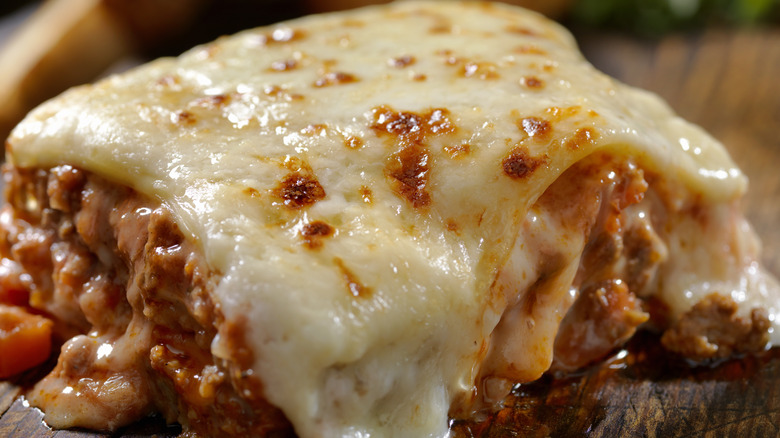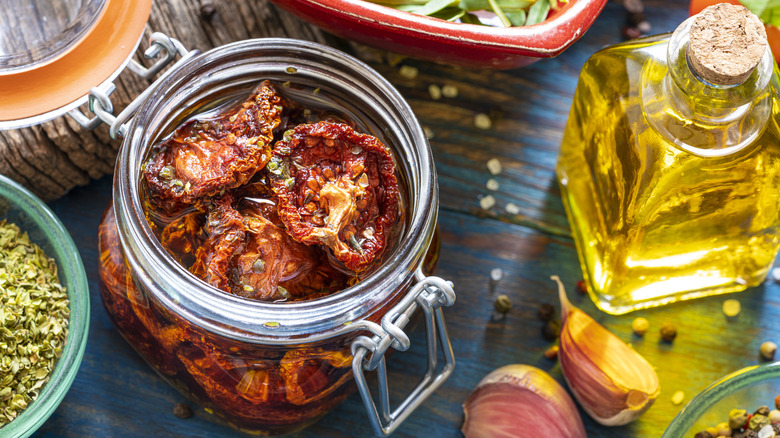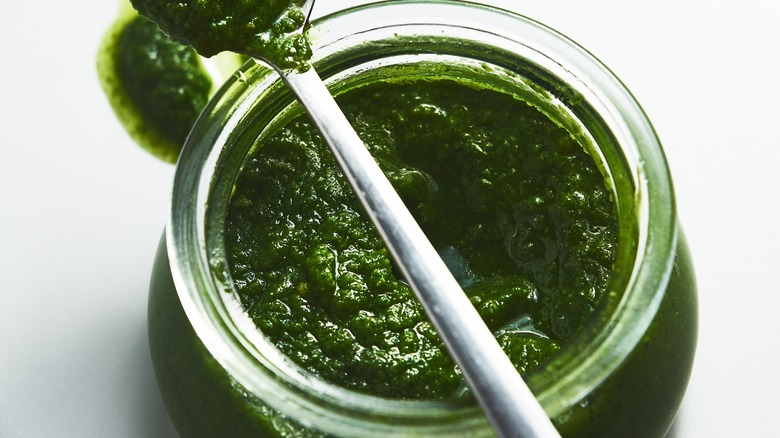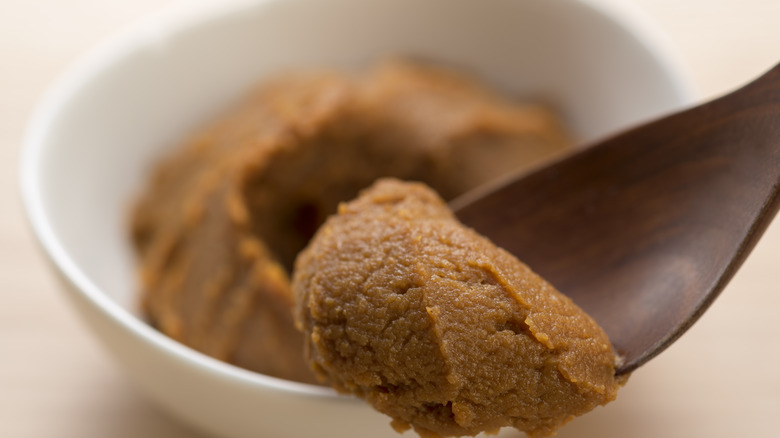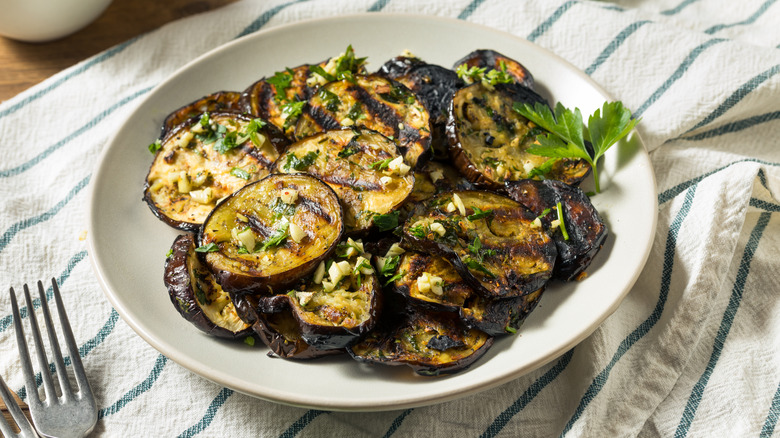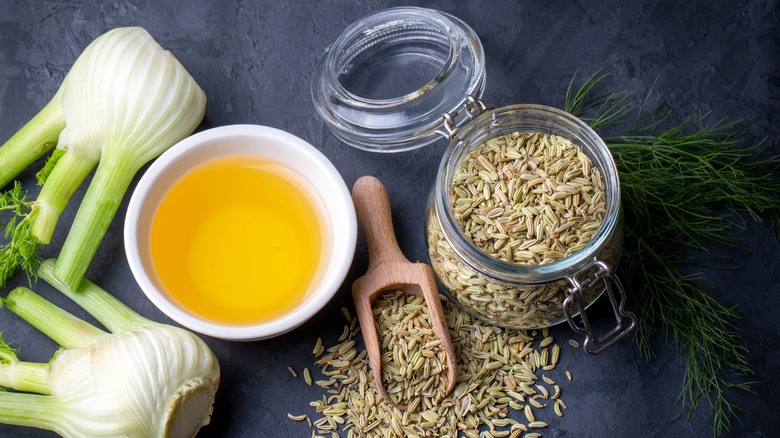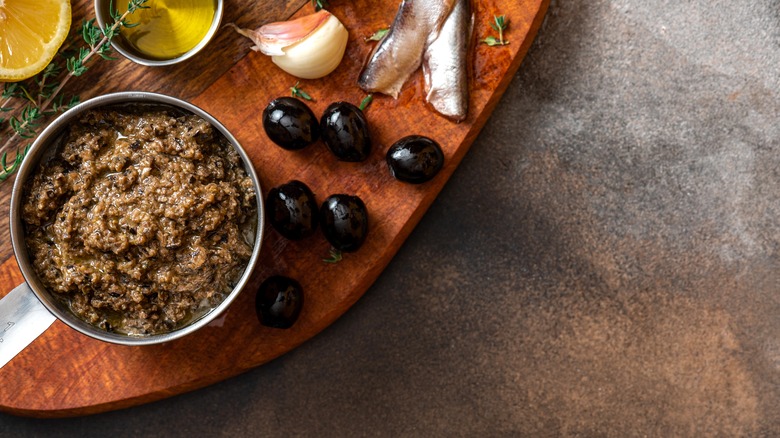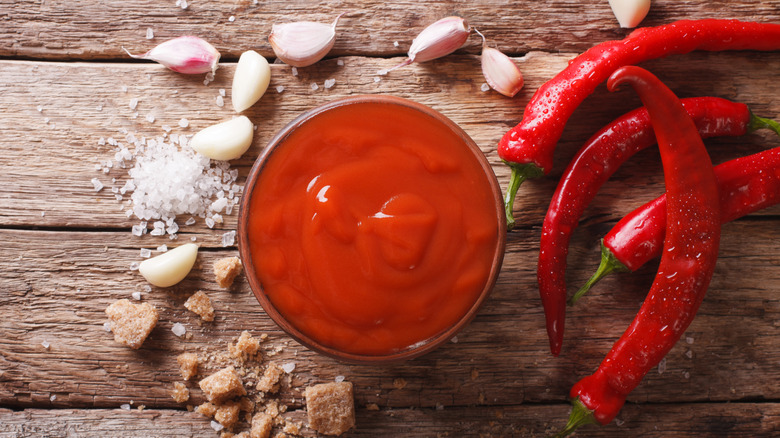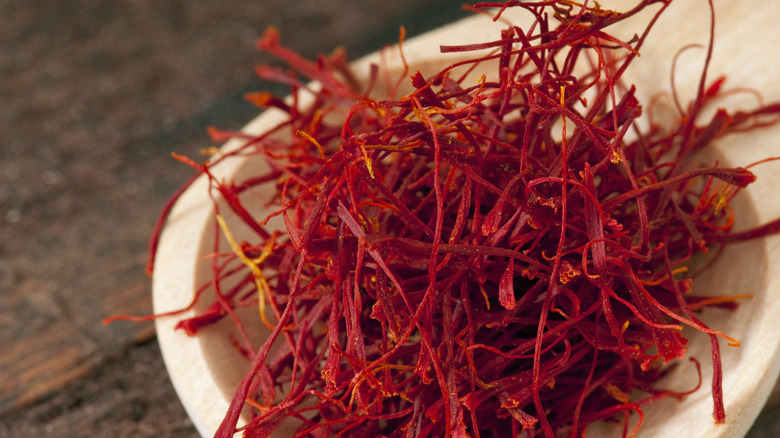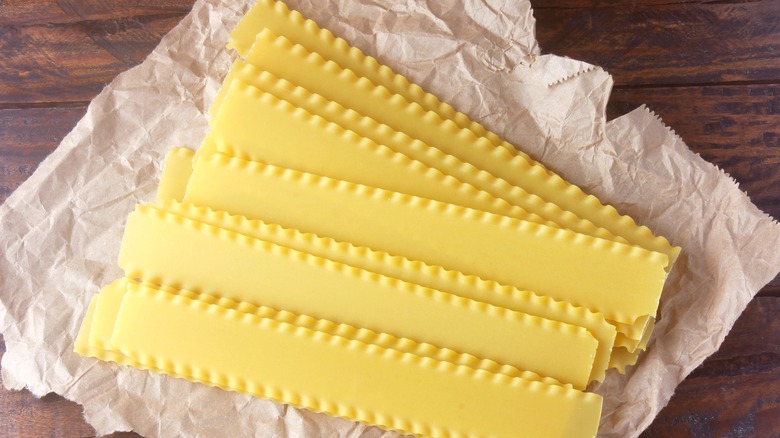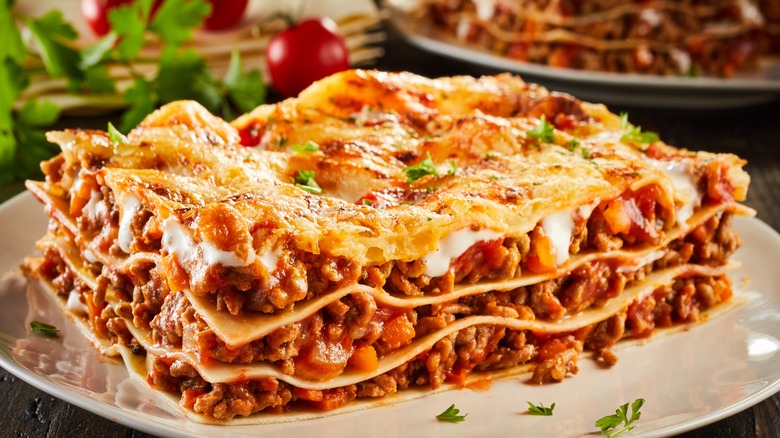12 Ingredients You Should Be Using In Your Lasagna
Lasagna is one of those rare dishes you almost can't get wrong — and there are so many ingredients that work perfectly with lasagna. Time's short? Use pre-made sauce. No fresh basil? Reach for dried. No sauce in the freezer? Open a jar. Whatever the ingredients, lasagna is sure to win almost any food popularity contest. In fact, in 2022, it placed second next to garlic bread as the most popular Italian food in the United States. No surprise there. Like perfect garlic bread, a perfect lasagna is oozing with flavorful cheese. And then there are the noodles sandwiching all that deliciousness together. Lasagna was actually named for a noodle, appropriately enough – laganon, a fermented Greek noodle made from flatbread. During the Middle Ages, the Romans perfected and made the dish their own, and Italian immigrants brought it to North America in the early 1800s.
Part of lasagna's popularity is its versatility. You can create it out of just about anything. Your favorite style might be meaty bolognese, Neapolitan, or vegetarian, and the fillings can consist of everything from pork belly to tofu. In a pinch, you can even use frozen ravioli in place of traditional noodles. With all these choices, it's no wonder that you might have an opportunity for a stand-out dish. When you want to bring that lasagna to the next level, you must think outside the standard flavor box. These 12 ingredients will help you do just that.
Sundried tomatoes
Sun-dried tomatoes were the artichoke hearts of the late 1980s and early 1990s. Trendy and versatile, they splashed their tasty presence on menus everywhere, taking the cooking world — especially the pasta world — by storm. Salads and pastas were naturals for these instant flavor bombs, and they continue to show up in everything from orzo to tortellini. On pizza, they can be the standout, enhanced by only some chopped arugula and maybe some toasted pine nuts. On meatloaf — including chicken meatloaf – they make what could be an ordinary meal anything but. Over the years, they've proven they're more than just a fad — but while sun-dried tomatoes have become part of our cuisine, they've never become ordinary. That's because, unlike some fads, sun-dried tomatoes are really, really good. Of course, part of it is the way they look, glistening with oil, almost bursting with flavor. Some foods just seem happy, and that's the case with these tomatoes. They're pretty, they're easy to store and to use, and they have an earthy sweet-tart taste that adds rich nuances and texture to both your white and red lasagna sauces.
Mince them and add a pink tone to your béchamel sauce. Slice thinly and stir into your red sauce. However you choose to use sun-dried tomatoes, they will blend into the most complex mixture. When you get in the habit of keeping sun-dried tomatoes on hand, you'll never have to settle for boring anything — and that includes lasagna.
Pesto
When you think of definitive Mediterranean sauces, pesto will no doubt be one of the first thoughts that comes to your mind. It ranks second in the world, right under the traditional reds in popular sauces for pasta. What's not to love about basil, parmesan, pine nuts, and garlic whirled in luscious olive oil? It's been around since the Roman Empire, and the term pesto comes from "pestare," which means to crush, which pesto traditionally is — with a mortar and pestle, although you are no doubt getting yours from a jar. That's another benefit of pesto. It's easy to keep on hand for when inspiration strikes — or when you're desperate to create a great meal out of ingredients you have on hand.
Now, imagine that pesto stirred into your lasagna sauce or even spread over the noodles before you add the sauce. Most of us think of pesto as something to slather on a baguette. Pasta isn't much different. Pick a flavor, give it a sample taste first, and go from there. Remember that there's more to pesto than basil. Sometimes traditional isn't on the menu, and lasagna is the perfect palette for improvising. The next time you're looking for a different approach other than basil, garlic, and cheese, consider a cilantro pesto, lemon-pistachio, or even mint.
Miso paste
If you want to add umami and mystery to lasagna, reach for the miso paste. Yes, the same miso you use to glaze your salmon or spice up your noodles, will add a sultry layer to your lasagna. Miso is fermented soybean paste, which may not sound all that appetizing until you experience what it can do for any number of dishes, including lasagna. It began as the food of emperors and samurai back before Japanese farmers mastered fermentation in the 15th century and miso became accessible to anyone who could afford it. Today, we think of it primarily as an ingredient in Asian dishes, but its mellow flavor stands up to the heartiest lasagna sauce. Furthermore, it has an abundance of amino acids, protein, and probiotics, which is why it's a staple for many vegetarians, vegans, and those following a macrobiotic diet. In lasagna, it's that indefinable secret ingredient, and you need just a dab of it to deliver a lot of flavor.
Consider that a warning because miso can be sneaky. You've got to use it judiciously. Think of it like salt — because it is salty. Start with 1 tablespoon, taste as you go, and use only enough. Miso is categorized according to color based on how long it is fermented and whether the soybeans are steamed or boiled. White miso is the mildest form, followed by yellow, red, and brown. For lasagna, opt for a lighter miso. You don't want your lasagna to taste like ramen.
Grilled eggplant
Eggplant in lasagna is a classic combination, and traditional eggplant parmigiana substitutes slices of eggplant — often dipped in a beaten egg, covered in seasoned crumbs, and fried to crispy perfection — in place of lasagna noodles. Today, however, the crumb-covered eggplant slices are frequently roasted or grilled. And those pasta noodles aren't going anywhere. They live in harmony in creations like roasted chicken and grilled eggplant lasagna, where the eggplant is layered with chicken, ricotta, and cheddar cheeses. Instead of using eggplant to replace noodles, consider using it in addition to them. Eggplant makes itself known without overpowering the rest of the dish, and grilling slices will bring out its earthy, sweet flavor. You're not limited to one size fits all either. You can choose from a multitude including graffiti eggplant with its distinctive streaked flesh, to Barbarella, Indian, and Thai varieties. For lasagna, start with American or globe eggplants, and remember, the larger they are, the tougher their skin. Slender, curving Chinese eggplants tend to be milder than the larger ones.
You can grill your own eggplant if you're feeling industrious. A little olive oil, some salt, pepper, maybe a shake of garlic powder, and a pinch of salt are all you need. Lasagna isn't fast food though, and you may not want to take the time to get out the grill. In that case, you can order seasoned and grilled eggplant online or you can find it at some supermarkets, including many Whole Foods.
Espresso
Coffee deepens the flavor of any number of dishes and not just desserts. You can add it to pot roast, braised pulled pork, bread stuffing, and chili — and yes, even to martinis. Then there are the sauces. Coffee sneaks its way into everything from barbecue sauce to gravy, adding richness without stealing the show. Although it may have star status in your morning cup, it can just as easily take on the role of a supporting player. So of course it's a natural for lasagna. Its bitterness is a wonderful balance to the sweet and savory sauce ingredients. And why settle for mere coffee when you can choose the more intense espresso?
Adding espresso to lasagna is like adding fine wine. As it simmers, it loses its sharpness and blends into the overall mix. Just as some use cheap wine, claiming you can't tell the difference in a sauce, some use instant coffee. If that's all you have on hand, don't pass it up. It will work just fine. Start with 1 teaspoon diluted with water. Better yet, if you can't start your day without that morning espresso, put some aside and add that to your sauce. Want a touch of sweetness? Home and professional chefs have been adding a little sugar to lasagna to create that sweetness and balance. If you add sugar to your espresso, it will already be dissolved before it goes in. Delicious!
Fennel
This ancient spice has been around so long that Thomas Jefferson grew it and, according to some, proclaimed it his favorite over any vegetable or fruit. It has long been a staple of vegetarian dishes because it tastes like that very non-vegetarian dish known as sausage. However, with or without meat, this member of the carrot family is right at home in lasagna. While Florence fennel, an annual, is grown for its sweet, anise-flavored stalks, sweet fennel, a perennial, produces the lacy foliage and seeds that work so well in lasagna. The foliage, which resembles dill, can be used the same way. Just chop it and add to the sauce.
The humble fennel seed does more than just provide that licorice kick to sausage. It also shows up in curries and — along with star anise, cloves, cinnamon, and Sichuan peppercorns — in Chinese five spice. For lasagna, sauté 1 teaspoon or more of the seeds in olive oil before adding to your sauce. You can also use fennel power you've ground yourself or purchased. Like any ground spice, it will be more intense as it simmers, so experiment until you've found the perfect balance.
Tapenade
You can add a pasta puttanesca vibe to lasagna as quickly as you can reach for a jar of tapenade. Yes, that fragrant combination can do more than act as a spread for crostini or sandwiches. The moment you open a jar of tapenade and breathe in that Mediterranean fragrance, you'll know why it's a perfect foil for your standout creations. Tapenade is so much more than olives. It's the best of the olive, that vibrant, almost decadent richness, combined with salty capers, for which tapenade is named – tapenas, the Provençal word for capers. Those two important ingredients are usually joined by olive oil and garlic, and sometimes anchovies. You can purchase — or make tapenade — with green, black, or a combination of olives. If you're making it, avoid those big black olives you stuck your fingers into as a kid and opt for briny kalamata, niçoise, and maybe green castelvetrano varieties.
Stir tapenade into your pasta sauce and watch the color and fragrance transform before your eyes. Spoon it along naked lasagne noodles before layering the sauce over them. Not into creatures of the sea? You can choose tapenade with or without anchovies. It is an especially important addition when you're using fresh tomatoes in your lasagne because the spicy olive blend will complement and blend with the sweet, acidic tomatoes.
Sriracha
Is there anything Sriracha cannot do? Season a steak. Perk up a dip. Elevate sliced melon. Tease grilled cheese. Substitute for Tabasco in a bloody mary. Almost anything but top an ice cream sundae — and someone has probably already done that with it. A relative newcomer that no one heard much about before 2008, it's now as ubiquitous as salsa and some would argue just as popular. It's also controversial. In fact, sriracha has become such an important ingredient that it even has its own imitators and wars over its origins. Is it the original recipe? Is it American, Vietnamese, or Thai? The stories are as intriguing as the combination of flavors.
The ingredients are pretty basic when you list them, just chili, sugar, salt, garlic, and distilled vinegar. But Sriracha is more than the sum of its parts. Its popularity won it a place in fast food restaurants, yet it's the star ingredient in pho, a dipping sauce for spring or egg rolls, hot wings, any number of wraps and sandwiches, and some pretty explosive cocktails, including those made with mezcal, tequila, or rum. Don't think of it as just a hot sauce because it's much more. Need proof? Squirt a tiny bit into your same old sauce, even bottled sauce, and you'll instantly transform your lasagna from blah to the bomb.
Fish sauce
Considering its many uses in any number of exotic dishes, fish sauce ought to have a more glamorous name, but giving it one would be pretty hard to do because it's made up of well, fish, and water. Regardless of what you call it, fish sauce is an easy, indistinguishable way to add an umami finish to your lasagna sauce. Seafood has long been used in pasta sauces, including those for lasagna, just as the closely related Worcestershire sauce has been.
Worcestershire, that stealthy concoction — long praised for its ability to blend into any crowd of ingredients without attracting undue attention — is a staple in many pasta sauces. Yet its characteristic flavor comes from a secret combination of what is believed to be molasses, tamarind, garlic, and, yes, anchovies. So why not go straight to the source? Despite its name, you won't end up with a fishy taste when you reach for the fish sauce. Instead, you'll be adding something more interesting than plain salt that brings out the flavor of the other ingredients along with its own subtle undertones.
Saffron
There's something rich about saffron, and the price is only part of it. Known as "red dye," it comes from the stigma of a flower in the iris family. At one time, this lofty spice found its way into only the most elegant paella and bouillabaisse creations. Now that it's more available and affordable (although far from cheap) many are experimenting with it in pasta sauces. Sometimes, it's used as an ingredient in the pasta itself. Stirring in a few saffron threads is an excellent way to create an unexpected, delicate layer to lasagna. It adds a deep golden hue to béchamel sauce that makes the entire dish seem to glow from within.
Julia Child discovered saffron's adaptability decades ago when she combined saffron and orange peel to her French-accented lasagna sauce, a move that was far from traditional at the time. Today saffron teams with artichoke hearts and sometimes eggplant in vegetarian lasagna, and it enhances heartier sauces as well.
The right noodles
"Hold the noodles," said no lasagna fan ever. Creating lasagna is an art, and before you as much as begin, consider what type of noodles will work best with the lasagna you're craving. That's one of the most exciting parts of planning your signature lasagna because you can't go wrong. Homemade noodles bring an entirely new dimension to the dish — but if you lack the time and inclination to tackle that task, you can buy dried noodles that work perfectly.
Searching for the perfect lasagna noodle is a job nobody minds. All you need are some general guidelines and plenty of time to experiment. The noodles you're seeking should be broad and flat — for traditional lasagna at least. They should be sturdy enough to withstand any number of ingredients and any amount of cooking time. Small or flimsy noodles will end up drowning in your sauce instead of holding it together. Pay attention to cooking time. Overcooked noodles can transform your lasagne from magnificent to mush before your ingredients have a chance to meld. Undercooked noodles — and we've all been there — will add an unforgettable, never-to-be repeated leathery texture. Although almost everything that goes into a lasagna is negotiable, many chefs warn against oven-ready or no-boil lasagna sheets. They say this type of pasta affects the overall texture of the dish.
A pangrattato topping
You've prepared an exquisite lasagna. You've chopped, blended, grated, tasted — and brought your creation to an art form with a variety of perfectly blended ingredients. But wait. You aren't going to just stick it in the oven with no topping, are you? That's right. This is definitely a time you want to gild the proverbial lily. To enhance that creamy blend of flavors, you need some crunch. Enter your topping. After all, the best lasagna is all about layers, and your top layer needs to be special. Sure, you could simply grate some cheese and stick the pan under the broiler. No one will complain. But if you really want that finishing touch, consider pangrattato.
In Italian, the word means "grated bread," and if the name is unfamiliar, perhaps you've heard it referred to as "poor man's parmesan," which is its popular nickname. That's because pangrattato is sometimes used as a replacement for that pricey parm by those who don't want to spend the money. It's also often the choice of those who don't eat dairy. Maybe you're not into replacing your parmesan. You just want a crispy, delicious topping for your lasagna. In that case, add the grated parmesan to the grated bread crumbs. Toast the mixture in a little olive oil with chopped garlic, your choice of herbs, and maybe some parsley. Top your lasagna with it right before putting it into the oven. Save any leftover crumbs and add them to soups, salads, and vegetable dishes.

